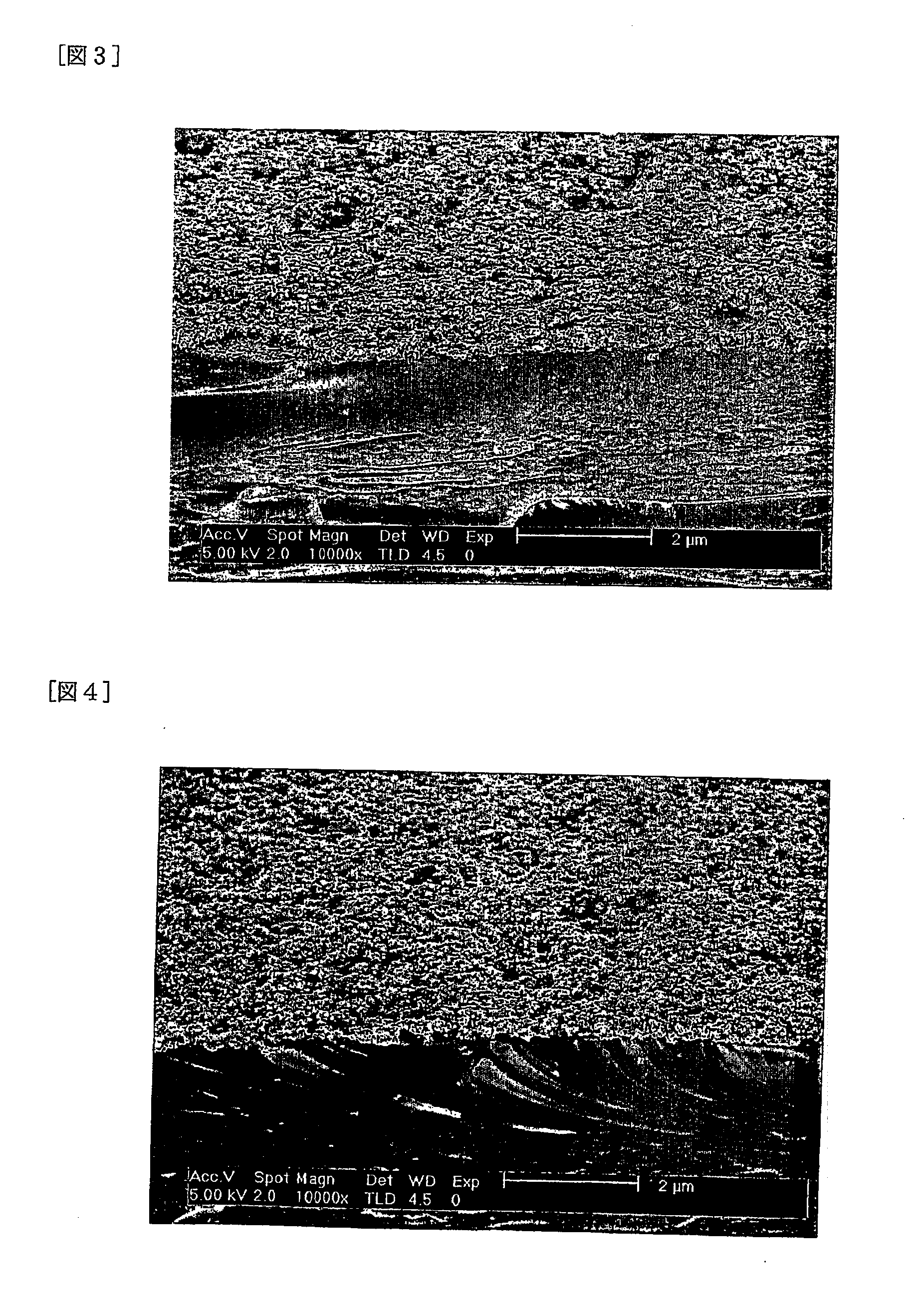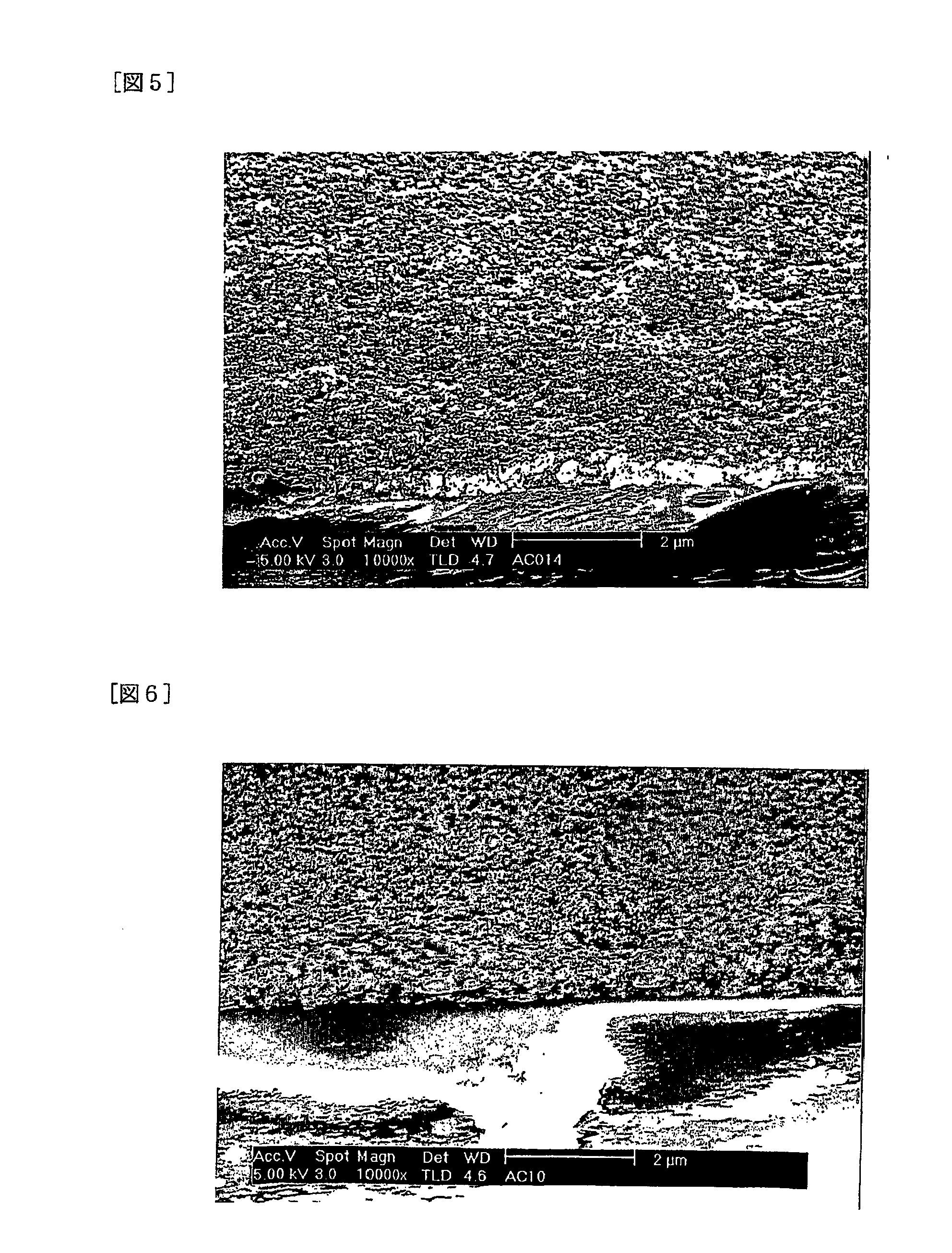Conductive Ink
a technology of conductive ink and inkjet printing, which is applied in the direction of non-metal conductors, applications, conductors, etc., can solve the problems of inability to achieve the flat surface of the conductor surface, the inability to achieve multi-layer wiring, and the inability to use the conductive ink itself in the inkjet printing method. , to achieve the effect of reducing electric resistance, excellent adhesion and large features
- Summary
- Abstract
- Description
- Claims
- Application Information
AI Technical Summary
Benefits of technology
Problems solved by technology
Method used
Image
Examples
example 1
[0104]In this Example, a conductive ink was prepared by the following procedures; an electrode film was formed using the conductive ink; and the performances on the conductor resistance, adhesion and cross section of the electrode film were examined.
[0105]445.28 g of ethylene glycol in a reaction vessel charged with 31.31 g of nickel hydroxide, 2.15 g of polyvinylpyrrolidone (PVP), 0.69 ml of a 100 g / l palladium nitrate solution and 1.0 g of L-arginine was heated for 10 hours at 190 deg. C. while being stirred and nickel particles having an average primary particle size of 37.86 nano meter was obtained. This reaction solution was subjected to decantation using ethylene glycol to rinse and remove PVP contained in the reaction solution. Further, decantation was subjected twice using terpineol to produce a nickel slurry containing 80% by weight of nickel powder and terpineol as the balance.
[0106]Examination results on the primary particle size (average, standard deviation, maximum valu...
example 2
Preparation of Conductive Ink
[0114]In this Example, a conductive ink B was prepared in the same manner as in Example 1 except that citrate nickel is used as the film density improver to be added. Therefore, in order to avoid repeated description, the description of the manufacture process herein is omitted.
Measurement of Film Resistance:
[0115]Film of the above conductive ink B was formed on an alkali-free glass substrate OA-10 (manufactured by Nippon Electric Glass Co., Ltd.) by using a spin coater (manufactured by MIKASA Company) with 2500 rpm for 10 seconds. The specific resistance of the electrode film was 2.5×10−4 Ohm·cm, measured by a four-probe resistance measuring apparatus: RORESTER GP (manufactured by Mitsubishi Chemical Co., Ltd.).
Evaluation of Adhesion:
[0116]The adhesion of the electrode film to a glass substrate show good adhesion of class 0 when examined by a cross cut method according to JIS K 5600, paragraphs 5 to 6. On the electrode film prepared as described above a...
example 3
Preparation of Conductive Ink
[0118]In this Example, a conductive ink C was prepared in the same manner as in Example 1 except that copper acetate is used as the film density improver to be added. Therefore, in order to avoid repeated description, the description of the manufacture process herein is omitted.
Measurement of Film Resistance:
[0119]Film of the above conductive ink C was formed on an alkali-free glass substrate OA-10 (manufactured by Nippon Electric Glass Co., Ltd.) by using a spin coater (manufactured by MIKASA Company) with 2500 rpm for 10 seconds. The specific resistance of the electrode film was 5.92×10−4 Ohm·cm, measured by a four-probe resistance measuring apparatus: RORESTER GP (manufactured by Mitsubishi Chemical Co., Ltd.).
Evaluation of Adhesion:
[0120]The adhesion of the electrode film to a glass substrate show good adhesion of class 0 when examined by a cross cut method according to JIS K 5600, paragraphs 5 to 6. On the electrode film prepared as described above ...
PUM
| Property | Measurement | Unit |
|---|---|---|
| Viscosity | aaaaa | aaaaa |
| Surface tension | aaaaa | aaaaa |
| Surface tension | aaaaa | aaaaa |
Abstract
Description
Claims
Application Information
 Login to View More
Login to View More - R&D
- Intellectual Property
- Life Sciences
- Materials
- Tech Scout
- Unparalleled Data Quality
- Higher Quality Content
- 60% Fewer Hallucinations
Browse by: Latest US Patents, China's latest patents, Technical Efficacy Thesaurus, Application Domain, Technology Topic, Popular Technical Reports.
© 2025 PatSnap. All rights reserved.Legal|Privacy policy|Modern Slavery Act Transparency Statement|Sitemap|About US| Contact US: help@patsnap.com



